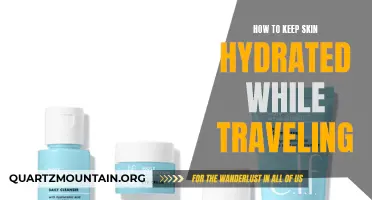
Have you ever wondered how to adjust the travel path in Cura to optimize your 3D prints? Mastering travel path adjustment in Cura is a crucial skill to ensure flawless and customized prints. By being able to tweak the travel path, you can minimize stringing, reduce print time, and even improve the overall aesthetics of your prints. In this guide, we will delve into the intricacies of travel path adjustment in Cura and provide you with valuable tips and tricks to achieve the best results possible. So, whether you are a beginner or an experienced 3D printer, get ready to take your prints to the next level with this comprehensive tutorial on mastering travel path adjustment in Cura!
What You'll Learn

Introduction to Changing Travel Path in Cura
Cura is a popular slicing software used for 3D printing. It allows users to prepare their 3D models for printing by converting them into a format that can be understood by the 3D printer. One of the features that Cura offers is the ability to change the travel path, which can be helpful in reducing stringing and improving the overall print quality.
The travel path refers to the movement of the 3D printer's nozzle between different parts of the print. During the printing process, the nozzle needs to move from one area to another to print different sections or layers of the model. The travel path can have a significant impact on the print quality, especially when it comes to stringing or oozing of filament between different print areas.
Changing the travel path can help to reduce stringing and oozing by optimizing the movement of the nozzle. By carefully planning the travel paths, you can minimize the distance traveled by the nozzle when moving between different parts of the print. This can reduce the chances of filament oozing or stringing, resulting in cleaner and more accurate prints.
To change the travel path in Cura, follow these steps:
- Open Cura and load your 3D model.
- Go to the "Settings" menu and select "Configure settings visibility."
- In the settings visibility window, enable the "Travel" option.
- Close the settings visibility window.
- In the sidebar, click on the "Travel" tab.
- Here, you will find various settings related to travel, including "Combing mode," "Avoid printed parts when traveling," and "Enable retraction."
Combing mode: Combing is the movement of the nozzle along the already printed parts of the model without retracting the filament. By default, Cura uses "Not in skin" combing, which avoids combing over external surfaces. However, you can experiment with different combing modes to see which one works best for your prints.
Avoid printed parts when traveling: Enabling this option instructs Cura to avoid traveling over printed areas when moving between different parts of the print. This can help to reduce stringing and oozing.
Enable retraction: Retraction is the process of pulling the filament back slightly when the nozzle is moving over non-printed areas. This helps to prevent oozing and stringing. Make sure this option is enabled in Cura to take advantage of retraction.
Adjust the settings according to your needs and preferences. You can experiment with different values to find the optimal settings for your specific 3D printer and filament.
Changing the travel path in Cura can significantly improve the print quality by reducing stringing and oozing. By carefully adjusting the travel settings, such as combing mode, avoiding printed parts when traveling, and enabling retraction, you can optimize the movement of the nozzle between different parts of the print. This can result in cleaner and more accurate prints, ultimately enhancing your overall 3D printing experience.
Exploring China: Journeying Through the Land of Rich Culture and History with a Tourism Visa
You may want to see also

Steps to Change Travel Path in Cura
Cura is a popular slicing software used by 3D printer enthusiasts to prepare their models for printing. One of the many features it offers is the ability to change the travel path of the printer head. This can be useful in situations where you want to optimize the printing process or improve the overall quality of the print. In this article, we will guide you through the steps to change the travel path in Cura.
Step 1: Open Cura
To begin, open Cura on your computer. If you don't have Cura installed, you can download it from the Ultimaker website and follow the installation instructions.
Step 2: Load your model
Next, load your model into Cura. You can do this by clicking on the "Open file" button in the top left corner of the screen or by dragging and dropping the model file into the Cura window.
Step 3: Go to the "Travel" settings
Once your model is loaded, click on the "Settings" menu at the top of the screen and select "Configure setting visibility" from the dropdown menu. In the settings visibility window, scroll down and enable the "Travel" category by checking the box next to it. Click on the "Close" button to save the changes.
Step 4: Adjust the travel settings
After enabling the "Travel" category, you will see a new tab called "Travel" in the settings panel on the right side of the screen. Click on this tab to access the travel settings.
In the travel settings, you will find various options to customize the travel path. Some of the commonly used options include:
- "Combing mode": This option determines how the printer head moves when it needs to travel from one point to another without extruding filament. The available options are "All", "Not in skin", and "Off". Choose the option that best suits your needs.
- "Avoid printed parts when traveling": Enabling this option will make the printer head avoid traveling over the printed parts. This can help reduce the chances of accidentally knocking over delicate or intricate details of your model.
- "Enable retraction": Retraction is the process of pulling back the filament to prevent oozing or stringing. Enabling this option will make the printer retract the filament whenever it needs to travel.
Step 5: Generate the g-code
Once you have adjusted the travel settings to your liking, click on the "Slice" button at the bottom right corner of the screen to generate the g-code for your model. The g-code contains all the instructions necessary for the printer to execute the print.
Step 6: Save and print
After generating the g-code, save it to your computer or directly to an SD card if you have a compatible printer. Insert the SD card into your printer and start the print.
By following these steps, you can easily change the travel path in Cura and customize it according to your preferences. Experiment with different settings to find the best travel path for your specific model and printing requirements. Happy printing!
How to Change Traveler Information on Hopper
You may want to see also

Tips and Tricks for Adjusting Travel Path in Cura
Cura is a popular slicing software used for 3D printing. It allows users to prepare their 3D models for printing by generating the necessary instructions for the printer. One important aspect of 3D printing is the travel path, which refers to the movement of the printer head between different parts of the model during the printing process.
By default, Cura automatically calculates the travel path based on the shortest distance between two points on the model. However, there are situations where you may want to manually adjust the travel path to optimize printing time, reduce the risk of filament dragging, or improve the overall print quality. In this article, we will discuss some useful tips and tricks for adjusting the travel path in Cura.
Enable "Avoid Printed Parts" Option:
One common issue in 3D printing is the filament dragging or oozing across parts of the model that have already been printed. To avoid this, you can enable the "Avoid Printed Parts" option in Cura. This option ensures that the travel path avoids touching any printed parts, minimizing the chance of filament dragging.
Adjust the Minimum Travel Distance:
By default, Cura tries to minimize the travel distance between different parts of the model. However, you can manually adjust the minimum travel distance to optimize the printing time. Increasing the minimum travel distance can reduce the number of unnecessary movements, resulting in a faster print. On the other hand, decreasing the minimum travel distance can improve the print quality by reducing the risk of filament oozing.
Use the "Combing" Feature:
The "Combing" feature in Cura allows the printer head to move within the already printed areas instead of performing a travel move. This helps to reduce the number of retractions and improve the overall print quality. By enabling the "Not in Skin" option in the combing settings, the printer head will only move within the inner walls of the model, further minimizing the risk of visible travel lines.
Enable "Z Hop" Option:
To further prevent the nozzle from dragging across the printed parts, you can enable the "Z Hop" option in Cura. This option lifts the printer head slightly during travel moves, ensuring that it doesn't touch any printed surfaces. However, it's important to note that enabling this option may increase the printing time and potentially introduce more stringing.
Adjust Printing Speed:
Another way to optimize the travel path is by adjusting the printing speed. Slower printing speeds can give the printer head more time to move between different parts of the model, reducing the risk of filament dragging. Experiment with different printing speeds to find the optimal balance between print quality and speed.
In conclusion, adjusting the travel path in Cura can greatly improve the overall print quality and reduce the risk of filament dragging. By enabling features like "Avoid Printed Parts," adjusting the minimum travel distance, using the "Combing" feature, enabling "Z Hop," and adjusting the printing speed, you can optimize the travel path to suit your specific needs. Experimentation and fine-tuning may be necessary to find the best settings for your printer and model.
Top Destinations You Can Travel to with a UAE Residence Visa
You may want to see also

Troubleshooting Common Issues when Changing Travel Path in Cura
Cura is a popular slicing software used by 3D printer enthusiasts to prepare their 3D models for printing. It offers many advanced features and settings, including the ability to change the travel path of the printer. The travel path refers to the path that the printer's nozzle takes when it moves between different parts of the print. By changing the travel path, you can optimize the printer's movements to reduce printing time and improve print quality.
However, changing the travel path in Cura can sometimes lead to unexpected issues. In this article, we will discuss some common problems that users encounter when changing the travel path in Cura and provide troubleshooting steps to resolve them.
Extruder oozing or dragging: One common issue that users face after changing the travel path is extruder oozing or dragging. This occurs when the printer's nozzle is not properly primed or retracted during travel movements, resulting in unwanted filament deposition or dragging across the print surface.
To resolve this issue, you can try the following steps:
- Increase the retraction distance: In Cura's settings, navigate to the 'Material' tab and increase the retraction distance. This will retract the filament further away from the print, reducing the chances of oozing or dragging.
- Enable 'Combing' or 'Z Hop': Combing is a travel optimization feature in Cura that avoids unnecessary retractions by moving the nozzle along paths that have already been printed. Enabling combing can help reduce the chances of oozing. Alternatively, enabling 'Z Hop' in the 'Travel' settings will lift the nozzle slightly during travel movements, preventing it from dragging across the print.
- Adjust the nozzle temperature: Decreasing the nozzle temperature slightly can help reduce the viscosity and flow of the filament, minimizing the chances of oozing or dragging.
Stringing or ghosting: Another issue that users encounter when changing the travel path is stringing or ghosting. Stringing refers to the presence of thin strands of filament between different parts of the print, while ghosting refers to the presence of ghost-like artifacts around the print caused by vibrations during travel movements.
To resolve stringing or ghosting issues, you can try the following steps:
- Increase the retraction speed: In Cura's settings, navigate to the 'Material' tab and increase the retraction speed. This will retract the filament at a faster rate, minimizing the chances of stringing.
- Enable 'Coasting': Coasting is a feature in Cura that stops extrusion slightly before the end of each printed segment. Enabling coasting can help reduce the pressure in the nozzle, minimizing the chances of stringing.
- Reduce print speed or acceleration: Stringing and ghosting issues can also be caused by excessive speed or acceleration during travel movements. Try reducing the print speed or acceleration in Cura's settings to see if it helps resolve the issue.
Print quality issues: Changing the travel path in Cura can sometimes lead to a decrease in print quality, such as gaps or artifacts in the printed object.
To improve print quality when changing the travel path, you can try the following steps:
- Enable 'Avoid Printed Parts While Traveling': This setting can be found in Cura's 'Travel' settings and instructs the printer to avoid traveling over printed parts, reducing the chances of causing damage or artifacts.
- Adjust the jerk or acceleration settings: Excessive jerk or acceleration values can cause the printer to jerk or shake during travel movements, leading to artifacts or gaps in the print. Try reducing the jerk or acceleration values in Cura's settings to see if it improves print quality.
In conclusion, changing the travel path in Cura can offer various benefits, including reduced print time and improved print quality. However, it is important to be aware of the potential issues that may arise and know how to troubleshoot them. By following the troubleshooting steps outlined in this article, you can effectively resolve common issues when changing the travel path in Cura and achieve better printing results.
Changing Your Known Traveler: A Step-by-Step Guide
You may want to see also
Frequently asked questions
To change the travel path in Cura, go to the "Travel" tab in the "Print Setup" menu. From there, you can adjust settings such as "Avoid Printed Parts" and "Combing Mode" to control the travel path of the nozzle.
Changing the travel path in Cura can help to optimize the printing process by minimizing the risk of collisions between the nozzle and already-printed parts. It can also help to reduce the appearance of stringing or oozing in the final print.
Cura does not provide a manual option for setting the travel path, as it is automatically generated based on the model geometry and the chosen settings in the software. However, you can influence the travel path by adjusting settings like "Avoid Printed Parts" and "Combing Mode" as mentioned earlier.
Yes, there are several plugins and add-ons available for Cura that can provide additional options for customizing the travel path. Some popular options include the "Print Sequence" plugin, which allows you to specify the order in which objects are printed, and the "Change at Z" plugin, which lets you change settings at different heights to control the travel path.







